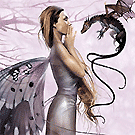Revealed van Gogh under another painting
Hidden van Gogh found at MFA - Mystery painting is under another work by artist.
By Geoff Edgers, Globe Staff Aug 4, 2007
For years, art scholars pondered a mystery: Did Vincent van Gogh create a painting that matches a sketch in Amsterdam's Van Gogh Museum?
The Dutch master created the lost painting, "Wild Vegetation," in 1889, during his stay at an asylum near Saint-Remy, France. The hidden work was found by chance when conservator Meta Chavannes X-rayed the MFA's painting, "The Ravine," about a year ago as part of a research project.
Chavannes found evidence of an image that didn't match "The Ravine," a moody landscape with swirling brush strokes of blue, gray, and green. A few weeks later, Chavannes shared the X-ray with Louis van Tilborgh, a curator at the Van Gogh Museum. He immediately recognized the image as being similar to a drawing in the museum's collection.
Van Gogh had sent the drawing, a riotous depiction of flowers and wildlife, to his brother, Theo, an art dealer in Paris. Re searchers have suggested that the drawing is one of several copies of paintings the artist sent to his brother in 1889, according to the MFA. But until now, curators were unable to determine whether a painting matching this particular drawing existed. Chavannes said she is still shocked at how quickly van Tilborgh found the drawing in his museum's collection.
"It was very absurd and surreal for him to pull out a composition so quickly," Chavannes said yesterday. The conservator says it is possible to see features of the earlier painting, including flowers, in sections of "The Ravine."
As famous for his use of dramatic brush strokes and bright colors as for his battles with mental illness, van Gogh created works that are today among the most famous and expensive of the post-Impressionist movement. The artist, who shot and killed himself at age 37 in 1890, struggled for public recognition during his lifetime. But in recent years, his paintings have sold for as much as $80 million at auction. "The Ravine," while prized by the MFA, is not one of the artist's most famous works. And until now, questions about the drawing in the Van Gogh Museum collection had attracted little attention outside the art world.
Throughout history, it has not been uncommon for artists to paint over old works, sometimes to save money, at other times because they were unsatisfied with an earlier creation. The French Impressionist Edgar Degas, for example, painted over some works more than 20 years after they were created. Typically, artists add a fresh layer of white paint to hide the older composition before creating a new one.
In his early years, van Gogh often reused canvases or turned them over and painted on the other side to make the most of his limited funds. But by 1889, a year before his death, he was being supported by his brother. Van Gogh painted over "Wild Vegetation" not because he couldn't afford to buy another canvas but because Theo was slow to send along new canvases, according to MFA curator George Shackelford.
"He was so eager to paint that he wasn't willing to wait," said Shackelford. "We deduce he decided to sacrifice a picture, maybe of the ones that he had that he liked the least, and he painted straight over the very highly patterned design of the first canvas without introducing a layer of white. It's fantastically amazing."
Chavannes was originally asked to research "The Ravine" by curators at the Phillips Collection and Cleveland Museum of Art, who were organizing a van Gogh exhibit. She found a 75-year-old X-ray in the painting's file, which piqued her interest. After taking a fresh X-ray, Chavannes saw the underlying pattern. At first, she tried to track down its source on her own.
"It became a bit of an obsession," said Chavannes. "I really wanted to see what it was showing."
She presented it to Shackelford, who couldn't identify the work. By chance, Chavannes, who is Dutch, was heading home to Amsterdam to visit family. She made an appointment with van Tilborgh.
A report on their discovery is being published this week in The Burlington Magazine, a London-based art journal. The Van Gogh museum will display the drawing in an exhibition that opens next week and runs through October.
As for "The Ravine," it remains on view in the Impressionist galleries at the MFA. The museum will hold a gallery talk on the discovery Sept. 5 and Nov. 8. It also hopes to produce a wall label explaining the discovery that will be placed next to the painting.
Geoff Edgers can be reached at gedgers@globe.com. For more on the arts, visit boston.com/ae/ theater_arts/exhibitionist. ![]()




0 Comments:
Post a Comment
<< Home